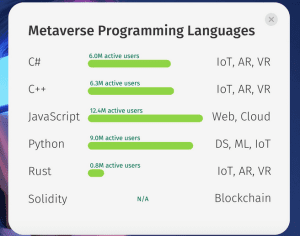
We will also look at the top metaverse development languages that occupy the resumes of metaverse development professionals.
The “Beyond Functional Programming: The Verse Programming Language” presentation was made available by Epic Games in December 2022. As a result, they offered numerous programming communities a chance to learn more about their brand-new metaverse programming language.
In his presentation for the Haskell eXchange online conference, Simon Peyton Jones did a fantastic job of describing the fundamentals of Verse. He gave a proper introduction before delving into various Verse programming language features.
What is the Metaverse?
When we try to explain the Metaverse in layman’s terms, we should note that it is a concept rather than a particular platform. It refers to the concept of a virtual online world, or a group of virtual online spaces, that we can access through virtual reality (VR) or augmented reality (AR), frequently with the use of blockchain and cryptocurrencies to ease transactional processes.
Unlike many of the spaces we are familiar with from games, these spaces will almost certainly be persistent and real-time. Events will take place in real-time as a result, and the area will remain occupied even if you leave it.
The Metaverse was previously only present in a few virtual worlds, such as Second Life and Entropia Universe, but thanks to Mark Zuckerberg, it is now widely known.
The Metaverse concept is becoming more significant as more aspects of our lives move online. The pandemic has accelerated this because it has forced more people to communicate online through video conferencing and virtual meetings.
Another factor that has made it possible is the accessibility of VR headsets, which were a previously expensive luxury items but are now becoming more widely available.
What is the Verse Programming Language?
The Verse programming language is a metaverse-specific programming language. This programming language is “functional-declarative” at its core. According to the latter, a variable actually identifies a single value rather than a cell whose value changes over time.
The Verse is a functional logic language as well (such as the programming languages “Curry” or “Mercury”). Additionally, it has an open-ended evaluation model with no set evaluation order.
The Verse is not “lazy,” and there are no instances where something is not evaluated at all. Instead, everything is assessed, though possibly out of order. Additionally, the static type system used by this programming language is unusual and distinct, treating types like first-class values. In addition, Verse employs an “effect system” rather than “monads.”
This metaverse programming language is also a result of Tim Sweeney’s vision to expand the immersive 3D social reality of the game world into the metaverse.
In addition, Tim, a C++ expert, thinks that the Web3 era requires a new programming language, one that is designed for the metaverse. As previously mentioned, you can view the presentation in the video below to learn more about the language in-depth.
Top Metaverse Development Languages Among Web3 Developers
Here, we will look at the top metaverse development languages that occupy the resumes of metaverse development professionals;
- C#
- Rust
- Solidity
- C++
- Javascript
- Python
- C#: Microsoft’s C# has gained popularity as a metaverse development language, as illustrated by the fact that it has been incorporated into a number of gaming engines.
Given the growing popularity of multi-chain application development and the unmatched scalability and interoperability that C# offers for metaverse development, the language will undoubtedly be useful in the years to come.
The C# programming language can be used to develop virtual reality-based metaverse applications. The C#-based Unity Game Engine has a large game developer community that is always helpful.
- Rust: For programmers looking to advance in this area, Rust is a good option. It is utilized for the development of cryptocurrencies, including the Solana blockchain, and focuses on performance and security. Rust is an open-source language with syntax that is similar to C++.
Originally a general-purpose programming language like C++, Rust gained Web3’s attention when Solana and Polkadot, major competitors to Ethereum, used it to develop their network from scratch.
- Solidity: Another language with a strong emphasis on blockchain development is Solidity, which was created specifically for the Ethereum blockchain. This makes it yet another helpful tool for developers who want to concentrate on the Metaverse’s blockchain component.
Metaverse developers can build the back-end of their virtual applications using the language on any EVM-compatible chain that leads ventures to gain access to the wider Web3 community.
- C++: C++ is frequently used in the creation of blockchains. As a result, C++ is another excellent object-oriented language to learn for Metaverse developers. Additionally, C++, like C#, has a wide range of non-Metaverse applications, making it a valuable skill for all developers.
- Javascript: JavaScript is one of the backbones of internet programming and is used in both Web 2.0 and Web 3.0 development, making it relevant for many Metaverse use cases.
JavaScript programs like node.js and react.js are frequently used for metaverse software development for applications capable of functioning across devices (PC, Mobile, and Browsers). JavaScript is arguably the most significant programming language in the Web3 world.
With other blockchain-related languages, starting from scratch has been very challenging. But because of the way JavaScript works, programmers can code each individual line. With the language, integrating additional Web3 components like VR and AR becomes simpler.
- Python: Python, a popular language for beginner programmers, has made its way into the creation of metaverse applications for a variety of reasons, along with its open-source support.
Python’s simple syntax and graphical user interface tools help programmers create metaverse platforms more quickly. Python is frequently used to create Web3 platforms for augmented reality-based applications.
Its compatibility with other programming languages, like C and C++, gives programmers flexibility when building platforms for the metaverse. The expanding Web3 community in Python contributes by offering development support libraries.
Wrap Up
We observed high demand among the Web3 developer community for the top metaverse development languages.
Each of them has advantages and disadvantages that are unique to each person’s needs. As far as we are aware, metaverse development is still a rapidly developing field with enormous unrealized potential.
Other languages besides this can also be used to create virtual worlds, but their application hasn’t been widely spread yet. For the best results, think about working with a professional firm that has staff members who are experts in the aforementioned languages if you need development specialists for your metaverse development project.



Comments 1